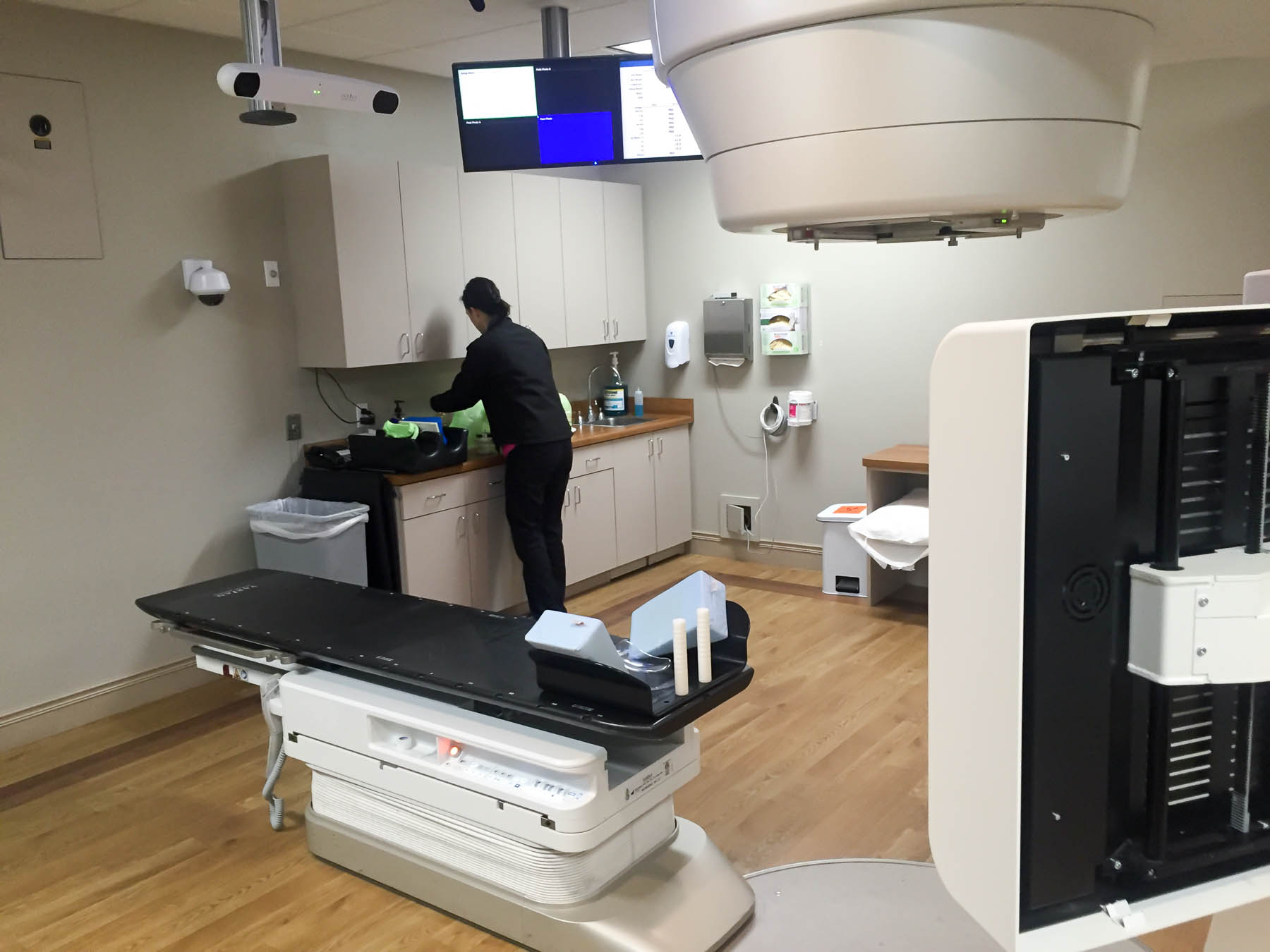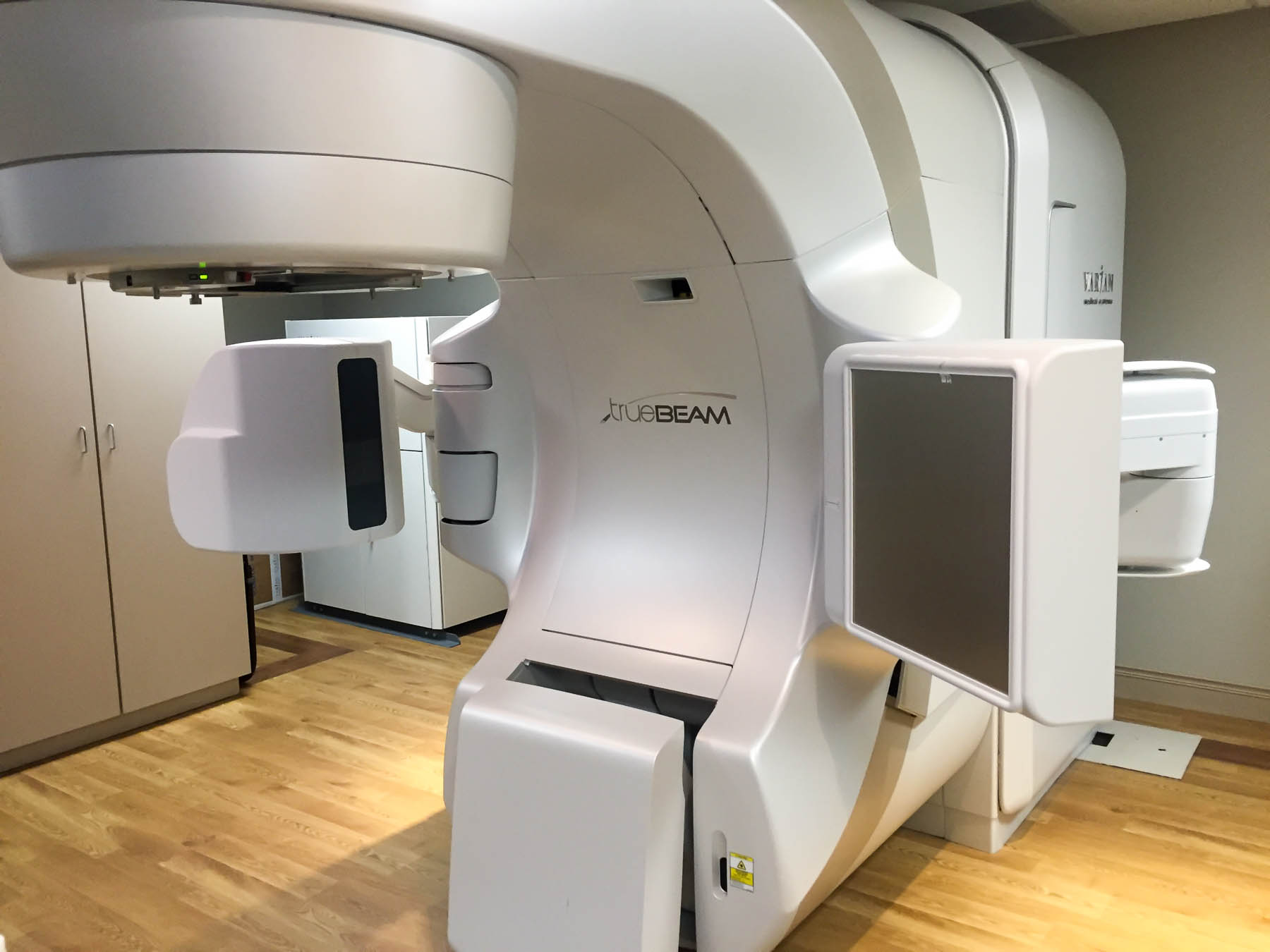The Radiation Routine
Posted 29 March 2016
Today I got my fifth dose of radiation, out of a total of ten sessions. Half way done! With treatments 5 days a week, it doesn’t take long to complete 10 treatments.
But First, the Setup
The radiation therapy process starts with two pre-treatment visits: one to the radiation oncologist for a consultation, and then a setup appointment.
At the setup appointment, I got yet another CT scan from a scanner with a special attachment: a set of lasers mounted on a large frame in front of the scanner. These lasers go across and up and down my body, allowing them to mark precise points of reference that correlate precisely with the CT scan.
The three spots on my body need to be marked in a way that they can be sure won’t get erased for at least two weeks, so they use a tried and true method: a tattoo. It isn’t much: each one looks like a small freckle. You’d have to know what you were looking for to find it.
The radiation oncologist then examines the 3D images generated by the CT scanner and defines the area for the radiation to target. This is an incredibly critical and difficult task. Target too little, and the treatment won’t be effective. Target too much, and the side effects can be substantial and permanent.
This is one of those times when all you can do is make sure you’re in the hands of an expert, and then give yourself over to his or her expertise.
Today, the doctor showed us my CT scan and how they planned the treatment. There are three beams, one from above and one from each side. It is only where the three beams cross that the full dose is delivered. Starting from the CT scan, the doctor and the technicians outline the tumor boundary, as best they can. Then they enlarge it a little bit for margin, so that the entire tumor will be irradiated even as I breathe or my body shifts slightly.
The technicians outline all the critical areas that should get minimal radiation, like my kidneys. Varian’s Eclipse treatment planning software then calculates the three beams to best achieve these goals.
Ten Daily Treatments
Once the planning is done, the ten treatments, five days a week, are quick and easy, if not comfortable.
Irene drives me down — some days Rio comes too.
I have a card with a barcode on it, and to check in I just put it under the scanner at the front desk.
Then I go back to the changing room, take off my shirt, put on the “gown”, and sit in the waiting area. After a few minutes, they come and get me, and we walk through broad circuitous hallways to the radiation machine.

I lay down on the fiercely uncomfortable table. I’m only on it 5 to 10 minutes, though, and the goal is to have my body position be as stable as possible, so no cushioning — just a hard composite surface. Then I put my arms above my head and grab the conveniently located handholds.
Two technicians stand on opposite sides of me and push and prod my body until they get the three dots lined up with the lasers. This aligns me with the plan.

Then they leave the room, and the machine gets to work. First, two panels rise up on either side of me. One is an X-ray emitter (on the left in the photo above), and the other is the X-ray sensor (on the right). The technicians in the other room examine the X-ray to confirm that I’m in the right position, lining up my spine in the X-ray with where the plan says it should be. They sometimes make very small adjustments by remotely shifting the table position.
Then the X-ray panels move out of the way, and there’s perhaps 30 seconds of radiation from above me, facing my abdomen as I’m lying down. (The radiation comes from the round unit at the top of the photo.) Then the head rotates into position on my right side, gives another 30 second dose, moves 180 degrees to give my left side its 30 seconds, and then it’s all over.
The whole process is somewhat surreal. The machine is big, and moves a lot, and the other people are always out of the room when it is operating. The radiation that is doing all the work is invisible and I don’t feel it at all.
The entire process doesn’t take much longer than it took you to read this. Each patient has a 10-minute time slot on the machine, and that includes getting on, getting aligned, being treated, and getting out.
Modest Side Effects
So far, I’m glad to say that the side effects have been modest. I’ve been somewhat nauseated, my digestion is working a little less well, and I am perhaps a bit more tired, but overall it is entirely tolerable. The effects are cumulative, however, so we’ll see how I feel at the end.
Unless you are one of the unlucky few who have permanent side effects, the side effects generally fade fairly quickly over the first few weeks after treatment ends.
I am anxious, of course, about whether the radiation is doing the job. Only time will tell, but it is hard to be relaxed about this. I’ll know in about two weeks.
Full of Ironies
Radiation is a major cause of the DNA damage that causes cancer. Then we use a higher dose of radiation to kill off the cancer. Is that not ironic?
Another strange connection: The machine that enables radiation therapy is the linear accelerator, whose invention predates World War II but benefited from the massive funding put into developing nuclear technology for the atomic bomb. And PET scans wouldn’t be possible without cyclotrons, which have a similar history.
So now I am the beneficiary of all this nuclear technology, which at one time was so easy to consider evil, in the form of a $2.7 million Varian trueBEAM machine and a team of experts who operate it.

The description of the beams, body position etc…you could probably plan a hell of a jewel heist after all this!
reminds me that one location describes a point; two, a line; and three, a plane.
geometry and health!
I don’t recall anyone I know describing any procedures the way you have. I’m picturing you in elementary school and somehow it makes perfect sense. Your attention to detail has been lifelong. Sending love, As always.